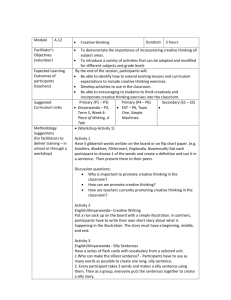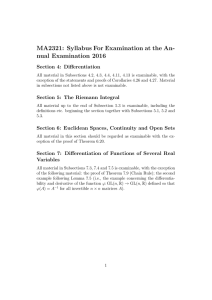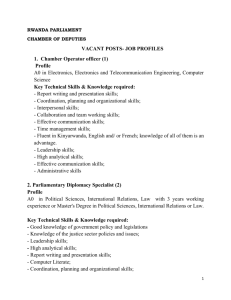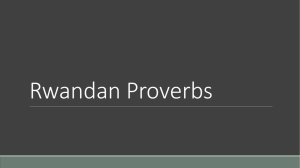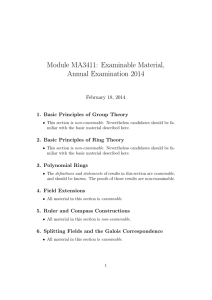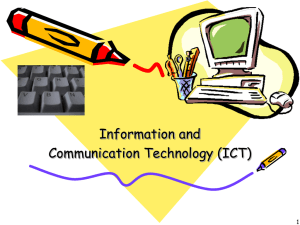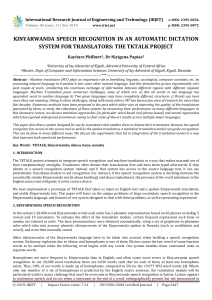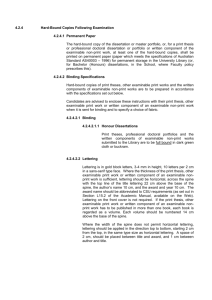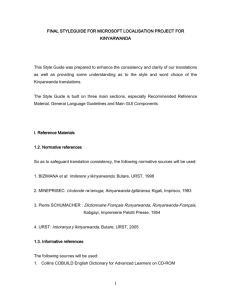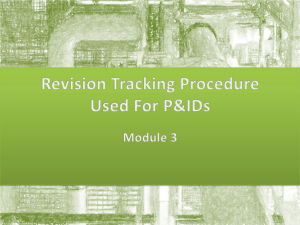Presentation from CPMD_REB
advertisement
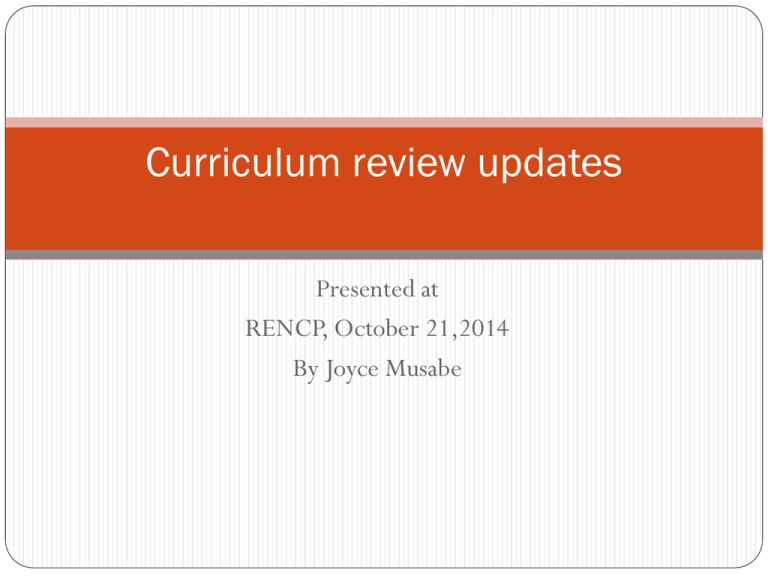
Curriculum review updates Presented at RENCP, October 21,2014 By Joyce Musabe Background and Major revisions Curriculum in 1962-1978 The structure of education system was 6-3-3 The language of instruction in lower primary was Kinyarwanda The subjects mainly taught in primary were: Mathematics, Kinyarwanda, Religion, and French. There was little exposure in history and geography. 2 Background and Major revisions Curriculum 1978-1992 New education structure of 8-6 Language of instruction in primary was Kinyarwanda Subjects taught at primary were Maths, French, Kinyarwanda, Religion, Crafts, needlework, and home economics in some schools Specialization started right from form one 3 Background and Major revisions Curriculum 1992- 2009 The structure of education system was 6-3-3 National conference of April 24th 1995 recommended the restructuring of education system Harmonization of the curricula in 1996 Official languages of instructions: Kinyarwanda (lower primary, from upper primary either French or English) 4 Background and Major revisions Curriculum 2009-up to date Introduction of double shift in upper primary. Reduction of the number of core subjects. Introduction of compulsory and elective subjects. Official languages of instructions: Kinyarwanda in lower primary and English at all other levels. 5 Rationale and objective Vision 2020, EDPRS2 ,ESSP (2013-2018) - the Rwanda Curriculum requires a renovation to meet the demands of the country’s vision and the dynamic global skills market demands. To allow the free movement of workers in the region and in the world. These involve turning Rwanda into a knowledge-based society whilst the aspiration is that the reformed curriculum should reflect the best of curricula in the developing world and embody best practices. 6 Activities achieved with the review Conducted studies on existing curriculum and subject syllabuses (July 2013 – November 2013) Held a National Curriculum Conference involving all stakeholders aimed at debating, refining and disseminating the recommendations of the studies (November 2013). The structure of the curriculum framework and the development of time tabled road map plotting the work to be undertaken and key deadlines (December2013-February 2014) 7 Activities achieved with the review Identification of subjects to be taught at all levels including 8 the combinations. Identification of competencies and Leavers profiles and crosscutting issues Subjects’ overviews ( topics, subtopics and topic competencies in every subject and at each level of the learner. Elaboration of competence based syllabus (determine on grade by grade basis, what children must learn, how they should learn, related learning activities) Competencies Basic : Numeracy, literacy- Communication in mother tongue and in official foreign languages- Science and technology- ICT and digital competency- Personal and interpersonal management and life skills- Citizenship and national identity- Entrepreneurship and business development and Lifelong learning 9 Generic: Critical thinking Research and problem solving Creativity and innovation Communication Co-operation What is new with Pre primary Foundations of literacy, numeracy and social skills through play based learning Helping students to discover their world ( people and community and living things, physical features and technology Social and emotional development Physical development and healthy care 10 What is new in Primary Increased the number of subjects : 7 and 8 instead of 5 respectively in upper and lower primary Created space for all subjects to be compulsory Introduction of French and ICT Number of weeks per year: 39 instead of 36 11 What is new in Lower secondary Core subjects: 12 ( examinable in national exams) Elective subjects: 1 subject chosen /examinable Co- curricula activities: All compulsory but not examinable Number of periods per week: 45 instead of 38 Number of weeks per year: 39 instead of 36 12 What is new In Lower secondary Some changes in subjects: History and Citizenship Biology and Health sciences Geography and Environment French and Literature in English ICT in education All above compulsory and be examinable 13 A level combinations 8 Combinations in Sciences 6 Combinations in Humanities 3 Combinations in Languages 14 What is new at Upper secondary Focus on communication skills, languages in all combinations Focus on Subsidiary Mathematics in sciences and humanities with economics Elective subjects are examinable in national exams Number of periods per week: 45 instead of 36 Number of weeks per year: 39 instead of 36 15 Methodology used and participants Beside consultation, interviews there was a full participatory approach involving relevant stakeholders from: Teachers and lecturers FBO Government and Private Institutions ( WDA, CNLG, Itorero, GMO, Unit and Reconciliation, RBS, REMA, AEGIS/Trust, MINECOFIN /Financial Education, Wellspring Foundation…) PSF EDC/L3 and EDC/Akazi kanoze Right to play 16 Upcoming activities Development of Assessment guidelines of each level 17 November-December 2014 Launching the new curriculum in end December 2014. Elaboration of Learning and Teaching Materials in line with the new curriculum ( 2015) Training teachers in the use of the new curriculum ( 2015) Implementation of competency-based curriculum (Jan 2016 to 2018) Monitoring and evaluation ( 2018) Challenges The weekly time allocation of 45 periods per week pushes the school day to 4 pm as opposed to 2 pm as it was in the existing curriculum. This implies that issues of school feeding need to be considered urgently Funding the remaining activities for proper implementation of the new curriculum from Jan 20162018) 18 Good news!!! “We can do all things through Christ who strengthen us” (Apostle Paul) 19 THANK YOU 20
